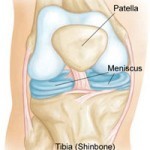Knees Often Sustain Injury, but Why?
We here at HealthNOW San Jose Physical Therapy, we see quite a few knee injuries. Your knee is the largest joint in your body and one of the most complex. Because you use it so much, it is vulnerable to injury. And due to its complexity and presence of multiple moving parts, many different things can go wrong.
What is a Meniscus?
Meniscal tears are among the most common knee injuries. Athletes, particularly those who play contact sports, are at risk for meniscal tears. However, anyone at any age can tear a meniscus. When people talk about torn cartilage in the knee, they are usually referring to a torn meniscus.
Your knee is composed of three bones: the thighbone (femur), the shinbone (tibia), and the kneecap (patella), as well as the soft tissue that connects them. Between your femur and your tibia are two C-shaped discs of cartilage that act as shock absorbers for the bones and help keep your knee stable. These are your menisci (plural of meniscus), and they can be torn, particularly if the knee twists suddenly while it is bent.

Viewed from the front or back, the meniscus is wedge shaped. This shape helps keep the rounded surface of your femur from sliding off the flat top of your tibia. The outer edges of this wedge receive a good supply of blood, and tears in this part of the meniscus heal well on their own. The inner part of the meniscus, however, has no direct blood supply. Tears in this area can require surgery to correct.
A torn meniscus is a common sports injury, particularly in contact sports such as football and hockey. Meniscus tears can range from minor to severe, depending on the extent of the damage, and they can make it difficult for the knee to function properly.
For teens, meniscus tears usually happen because of an injury. In older people, meniscus tears can be caused by degeneration of tissue as the menisci become brittle and less flexible with age. Cartilage weakens and wears thin over time. Aged, worn tissue is more prone to tears. Just an awkward twist when getting up from a chair may be enough to cause a tear, if the menisci have weakened with age.
Symptoms of a Meniscus Tear
The symptoms of a torn meniscus will vary depending on the severity of the tear. Someone who gets a minor tear may only have slight pain and swelling that goes away after 2 or 3 weeks.
Moderate to severe tears also might cause these symptoms:
a “pop” in the knee when the tear occurs
pain in the center or side of the knee, especially when twisting the knee or squatting. This will usually go away after a couple of weeks but can come and go for much longer if the tear is not treated.
swelling and stiffness in the knee that gets worse over the first 2 or 3 days after the injury occurs
limited range of motion
the knee feeling as if it is locking or popping when bending; it might not straighten
the knee feeling like it is giving way without warning
Go to a Trained Physical Therapist to Get Evaluated
If you see a physical therapist about pain in your knee, he or she will ask how you injured it and what it feels like. The therapist will also review your medical history to see if the pain might be caused by something other than a torn meniscus. The physical therapist also might order an X-ray to check for any degenerative or arthritic conditions that can cause knee pain or a magnetic resonance imaging (MRI) scan to get a better look at the soft tissue of your knee. We have trained physical therapists here at HealthNOW San Jose Physical Therapy, if you are currently looking for one.
After discussing your symptoms and medical history, your physical therapist will examine your knee. He or she will check for tenderness along the joint line where the meniscus sits. This often signals a tear. There are many orthopedic clinical tests to detect a meniscus tear. Your physical therapist will do these tests with you to determine which meniscus might be affected.
Chiropractic care to help realign the various bones of the knee joint is also helpful in speeding the healing process. The integration of both chiropractic and physical therapy is a highly effective method of working with such problems and why we have our team of both here at HealthNOW.
A Care and Rehabilitation Program is Tailored for You
After diagnosis is determined, the treatment needs to follow a specific protocol. If the management is non-surgical, then the physical therapist will perform certain manual therapy techniques and exercises along with electrical modalities to help the region heal.
If surgery is required, it is important to know that the post –operative physical therapy management is very crucial to get back to optimal functioning. It takes some work, but ensuring that your knee functions optimally for the rest of your life is a worthwhile outcome!
Have You Sustained A Knee Injury?
If you are suffering from any of the problems listed above—contact us at HealthNOW San Jose Physical Therapy for a FREE CONSULTATION. Call (408) 733-0400 to schedule. Our medical center is located in Sunnyvale, CA. If you are not local to us, our DESTINATION CLINIC treats patients from across the country and internationally. We will help you find the underlying root cause!
To your health,
Dr. Rupa Chakravarty
DPT, OCS